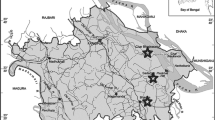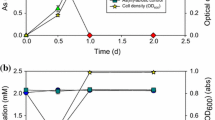Abstract
Arsenite [As(III)]-oxidizing bacteria play important roles in reducing arsenic [As] toxicity and mobility in As-contaminated areas. As-resistant bacteria were isolated from the soils of two abandoned mines in the Republic of Korea. The isolated bacteria showed relatively high resistances to As(III) up to 26 mM. The PCR-based 16S rRNA analysis revealed that the isolated As-resistant bacteria were close relatives to Serratia marcescensa, Pseudomonas putida, Pantoea agglomerans, and Alcaligenes sp. Among the five As-resistant bacterial isolates, Alcaligenes sp. strain RS-19 showed the highest As(III)-oxidizing activity in batch tests, completely oxidizing 1 mM of As(III) to As(V) within 40 h during heterotrophic growth. This study suggests that the indigenous bacteria have evolved to retain the ability to resist toxic As in the As-contaminated environments and moreover to convert the species to a less toxic form [e.g., from As(III) to As(V)] and also contribute the biogeochemical cycling of As by being involved in speciation of As.



Similar content being viewed by others
References
Anderson, G. L., Kove, M., & Zeider, B. K. (2003). Metabolic energy from arsenite oxidation in Alcaligenes faecalis. Journal of Physiology, 107, 49–59.
Anderson, G. L., Williams, J., & Hille, R. L. (1992). The purification and characterization of arsenite oxidase from Alcaligenes faecalis, a molybdenum-containing hydroxylase. Journal of Biological Chemistry, 267, 23674–23682.
Bardgett, R. D., Speir, T. W., Ross, D. J., Yeates, G. W., & Kettles, H. A. (1994). Impact of pasture contamination by copper, chromium, and arsenic timber preservative on soil microbial properties and nematodes. Biology and Fertility of Soils, 18, 71–79.
Canovas, D., Cases, I., & de Lornezo, V. (2003). Heavy metal tolerance and metal homeostasis in Pseudomonas putida as revealed by complete genome analysis. Environmental Microbiology, 5, 1242–1256.
Cervantes, C., Ji, G., Ramírez, J. L., & Siver, S. (1994). Resistance to arsenic compounds in microorganism. FEMS Microbiology Reviews, 15, 355–367.
Chang, J. S., Yoon, I. H., & Kim, K. W. (2007). Isolation and ars detoxification of arsenite-oxidizing bacteria from abandoned arsenic-contaminated mines. Journal of Microbiology and Biotechnology, 17, 812–821.
Cheng, C. N., & Focht, D. D. (1979). Production of arsine and methylarsines in soil and in culture. Applied and Environmental Microbiology, 38, 494–498.
Di Cell, F., Pepi, M., Baldi, F., & Fani, R. (1997). Molecular characterization of an n-alkane-degrafing bacterial community and identification of a new species. Research in Microbiology, 148, 237–249.
Edvantoro, B. B., Naidu, R., Megharaj, M., & Singleton, I. (2003). Changes in microbial properties associated with long-term arsenic and DDT contaminated soils at disused cattle dip sites. Ecotoxicology and Environmental Safety, 55, 344–351.
Ellis, P. J., Conrads, T., Hille, R., & Kuhn, P. (2001). Crystal structure of the 100 kDa arsenite oxidase from Alcaligenes faecalis in two crystal forms at 1.64 and 2.03 Å. Structure, 9, 125–132.
Ferguson, J. F., & Gavis, J. (1972). A review of the arsenic cycling in natural water. Water Research, 6, 1259–1274.
Frankenberger, W. T., Jr. (2002). Metal-oxide adsorption, ion exchange, and coagulation-microfiltration for arsenic removal from water. In D. A. Clifford & G. Ghurye (Eds.), Environmental chemistry of arsenic (pp. 217–245). New York: Marcel Dekker.
Hiroki, M. (1993). Effect of arsenic pollution on soil microbial-population. Soil Science and Plant Nutrition, 39, 227–235.
Jain, C. K., & Ali, I. (2000). Arsenic: Occurrence, toxicity and speciation techniques. Water Research, 34, 4304–4312.
Kashyap, D. R., Botero, L. M., Franck, W. L., Hassett, D. J., & McDermott, T. R. (2006). Complex regulation of arsenite oxidation in Agrobacterium tumefaciens. Journal of Bacteriology, 188, 1081–1088.
Le, X. C., Yalcin, S., & Ma, M. (2000). Speciation of submicrogram per liter levels of arsenic in water: On site species separation integrated with sample collection. Environmental Science and Technology, 34, 2342–2347.
Malasarn, D., Saltikov, C. W., Campbell, K. M., Santini, J. M., Hering, J. G., & Newman, D. K. (2004). arrA is a reliable marker for As(V) respiration. Science, 306, 455.
Maliszewska, W., Dec, S., Wierzbica, H., & Wozniakowska, A. (1985). The influence of various heavy metal compounds on the development and activity of soil microorganisms. Environmental Pollution A, 37, 195–215.
Mandal, B. K., & Suzuki, K. T. (2002). Arsenic round the world: A review. Talanta, 58, 201–235.
Masscheleyn, P. H., Delaune, R. D., & Patrick, W. H. (1991). Effect of redox potential and pH on arsenic speciation and solubility in a contaminated soil. Environmental Science and Technology, 25, 1414–1419.
Muller, D., Lievremont, D., Simeonobva, D. D., Hubert, J. C., & Lett, M. C. (2003). Arsenite oxidase aox genes from a metal-resistant β-proteobacterium. Journal of Bacteriology, 185, 135–141.
Nicomart, D., Dick, W. A., & Tuovinen, O. H. (2006). Assessment of the microbial community in a constructed wetland that receives acid mine drainage. Microbial Ecology, 51, 83–89.
Oremland, R. S., Hoeft, S. E., Santiono, J. M., Bano, N., Hollibaugh, R. A., & Hollbaugh, J. Y. (2002). Anaerobic oxidation of arsenite in Mono Lake water and by a facultative, arsenite-oxidizing chemoautotroph, strain MLHE-1. Applied and Environmental Microbiology, 68, 4795–4802.
Oremland, R. S., & Stolz, J. F. (2003). The ecology of arsenic. Science, 300, 939–944.
Osborn, F. H., & Ehrlich, H. L. (1976). Oxidation of arsenite by a soil isolate of Alcaligenes. Journal of Applied Bacteriology, 41, 295–305.
Parvez, F., Chen, Y., Argos, M., Hussain Iftikhar, A. Z. M., Momotaj, H., Dhar, R., et al. (2006). Prevalence of arsenic exposure from drinking water and awareness of its health risks in a Bangladeshi population: Results from a large population-based study. Environmental Health Perspectives, 108, 393–397.
Phillips, S. E., & Taylor, M. L. (1976). Oxidation of arsenite to arsenate by Alcaligenes faecalis. Applied and Environmental Microbiology, 32, 392–399.
Pierce, M. L., & Moore, C. B. (1982). Adsorption of arsenite and arsenate on amorphous iron hydroxide. Water Research, 6, 1247–1253.
Protass, J. J., Speyer, J. F., & Lengyer, P. (1964). Amino acid code in Alcaligenes faecalis. Science, 143, 1174–1176.
Rosen, B. P. (2002). Biochemistry of arsenic detoxification. FEBS Letters, 529, 86–92.
Salmassi, T. M., Venkateswaren, K., Satomi, M., Nealson, K. H., Newman, D. K., & Hering, J. G. (2002). Oxidation of arsenite by Agrobacterium albertimagni, AOL15, sp. nov., isolated from hot creek, California. Geomicrobiology Journal, 19, 53–66.
Saltikov, C. W., & Newman, D. K. (2003). Genetic identification of a respiratory arsenate reductase. Proceedings of the National Academy of Sciences of the United States of America, 100, 10983–10988.
Sambrook, J., & Russel, D. W. (2001). Molecular cloning: A laboratory manual (3rd ed.). New York: Cold Spring Harbor Laboratory Press.
Santini, J. M., Aimin Wen, L. I., Comrie, D., Wulf-Durand, P. D., & Macy, J. M. (2002). New arsenite-oxidizing bacteria isolated from Australian gold mining environments-phylogenetic relationships. Geomicrobiology Journal, 19, 67–76.
Santini, J. M., Sly, L. I., Schnagl, R. D., & Macy, J. M. (2000). A new chemolithoautotrophic arsenite-oxidizing bacterium isolated from a gold mine: Phylogenetic, physiological, and preliminary biochemical studies. Applied and Environmental Microbiology, 66, 92–97.
Santini, J. M., & vanden Heven, R. N. (2004). Molybodenum-containing arsenite oxidase of the chemolithoautotrophic arsenite oxidizer NT-26. Journal of Bacteriology, 186, 1614–1619.
Silver, S. (1996). Bacterial resistances to toxic metals—a review. Gene, 179, 9–19.
Silver, S., & Phung, L. T. (2005). Genes and enzymes involved in bacterial oxidation and reduction of inorganic arsenic. Applied and Environmental Microbiology, 71, 599–608.
Smedley, P. L., & Kinniburgh, D. G. (2002). A review of the source, behavior and distribution of arsenic in natural waters. Applied Geochemistry, 17, 512–568.
Stanier, R. Y., Palleroni, N. J., & Doudoroff, M. (1966). The aerobic pseudomonads: A taxonomic study. Journal of General Microbiology, 43, 159–271.
Tamaki, S., & Frankenberger, W. T., Jr. (1992). Environmental biochemistry of arsenic. Reviews of Environmental Contamination and Toxicology, 124, 79–110.
Tchounwou, P. B., Centeno, J. A., & Patlolla, A. K. (2004). Arsenic toxicity, mutagenesis, and carcinogenesis—a health risk assessment and management approach. Molecular and Cellular Biochemistry, 255, 47–55.
Ure, A. M. (1995). In B. J. Alloway (Ed.), Heavy metals in soils (pp. 55–68). Glasgow: Chapman & Hall.
US EPA. (2001). National primary drinking water regulations; arsenic and clarifications to compliance and new source contaminants monitoring. Federal Resister, 66, 6976–7066.
Vanden Hoven, R. N., & Santini, J. M. (2004). Arsenite oxidation by the heterotroph Hydrogenophaga sp. Strain. NT-14: The arsenite oxidase and its physiological electron acceptor. Biochemica et Biophysica Acta, 1656, 148–155.
Van Zwieten, L., Ayres, M. R., & Morris, S. G. (2003). Influence of arsenic co-contamination on DDT breakdown and microbial activity. Environmental Pollution A, 124, 331–339.
Walker, C., Goodyear, C., Anderson, D., & Titball, R. W. (2000). Identification of arsenic resistant bacteria in the soil of a former munitions factory at Löcknitz, Germany. Land Contamination and Reclamation, 8, 13–18.
Weeger, W., Lievremont, D., Perret, M., Lagarde, F., Hubert, J. C., Leroy, M., et al. (1999). Oxidation of arsenite to arsenate by a bacterium isolated from an aquatic environment. BioMetals, 12, 141–149.
Yoshida, T., Yamauchi, H., & Sun, G. F. (2004). Chronic health effects in people exposed to arsenic via the drinking water: Dose–response relationships in review. Toxicology and Applied Pharmacology, 198, 243–252.
Acknowledgments
This work was supported by the Korea Science and Engineering Foundation (KOSEF) through the National Research Lab. The program was funded by the Korean Ministry of Science and Technology (no. M10300000298-06J0000-29810).
Author information
Authors and Affiliations
Corresponding author
Rights and permissions
About this article
Cite this article
Yoon, IH., Chang, JS., Lee, JH. et al. Arsenite oxidation by Alcaligenes sp. strain RS-19 isolated from arsenic-contaminated mines in the Republic of Korea. Environ Geochem Health 31, 109–117 (2009). https://doi.org/10.1007/s10653-008-9170-0
Received:
Accepted:
Published:
Issue Date:
DOI: https://doi.org/10.1007/s10653-008-9170-0




